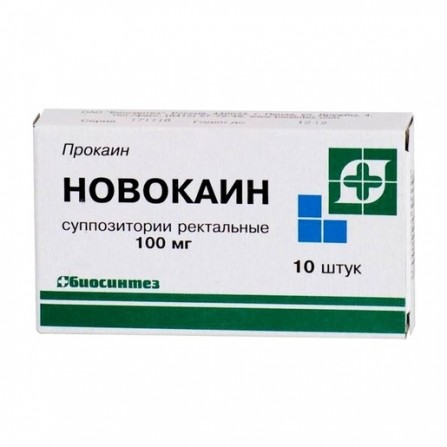Novocainum rectal suppositories 100mg N10
Condition: New product
1000 Items
Rating:
Be the first to write a review!

More info
Active ingredients
Procaine
Release form
Suppositories
Composition
Active ingredient: procaine hydrochloride - 0.1 g. Auxiliary substance: solid fat - sufficient amount to obtain a suppository weighing 1.1 g
Pharmacological effect
Local anesthetic with moderate anesthetic activity and a wide breadth of therapeutic action. Being a weak base, it blocks sodium channels, prevents the generation of impulses at the ends of sensory nerves and conduction of impulses along the nerve fibers. Changes the action potential in the membranes of nerve cells without a pronounced effect on the resting potential. Suppresses the holding of not only pain, but also pulses of another modality.
Pharmacokinetics
Subject to full systemic absorption. It is rapidly hydrolyzed by plasma and liver esterases to form 2 main pharmacologically active metabolites: diethylaminoethanol (it has a moderate vasodilating effect) and para-aminobenzoic acid (it is a competitive antagonist of sulfanilamide chemotherapeutic drugs and can weaken their antimicrobial action.
Indications
As a local anesthetic with hemorrhoids and anal fissures.
Contraindications
Hypersensitivity (including para-aminobenzoic acid and other local anesthetics, esters), children (up to 18 years).
Precautionary measures
Emergency operations accompanied by acute blood loss, conditions accompanied by a decrease in hepatic blood flow (for example, in chronic heart failure, liver disease), progression of cardiovascular failure (usually due to the development of heart block and shock), proctitis, pseudocholinesterase deficiency, renal failure in the elderly patients (over 65 years), seriously ill patients, debilitated patients, pregnancy, period of labor.
Use during pregnancy and lactation
During periods of pregnancy and breastfeeding, the drug should be used when the benefit to the mother exceeds the risk to the fetus or child.
Dosage and administration
Rectal. A suppository is inserted deeply into the anus (after a cleansing enema or spontaneous bowel emptying), preliminarily freeing the candle from the contour packaging using scissors (cutting the packaging along the contour of the candle). Apply 1 suppository 1-2 times a day. The duration of treatment as a local anesthetic is no more than 5 days.If the disease persists, you should consult a doctor.
Side effects
From the central and peripheral nervous system: headache, dizziness, drowsiness, weakness, motor restlessness, loss of consciousness, convulsions, tremism, tremor, visual and auditory disorders, nystagmus, horsetail syndrome (paralysis of the legs, paresthesia), respiratory muscle paralysis violation of sensory and motor conduction, paralysis of the respiratory center often develops with subarachnoid anesthesia. On the part of the cardiovascular system: an increase or decrease in blood pressure, peripheral vasodilation, laps, bradycardia, arrhythmias, pain in the chest. From the urinary system: involuntary urination. From the digestive system: nausea, vomiting, involuntary defecation. including anaphylactic shock), urticaria (on the skin and mucous membranes), dizziness, weakness, low blood pressure. In these cases, you should stop using the drug and consult a doctor. Local reactions: in the first days of the drug use, the urge to have a bowel movement and a feeling of discomfort, which later go away on their own and do not require discontinuation of the drug. Rarely - hyperemia and itching in the anus (when used in high doses). Overdosing methemoglobinemia. The effect on the central nervous system is manifested by a sense of fear, hallucinations, convulsions, motor agitation. Treatment: maintaining adequate ventilation of the lungs with inhalation of oxygen, intravenous administration of short-acting drugs for general anesthesia, in severe cases - detoxification and symptomatic therapy.
Overdose
Symptoms: pallor of the skin and mucous membranes, dizziness, nausea, vomiting, cold sweat, increased breathing, tachycardia, lowering blood pressure, until collapse, apnea, methemoglobinemia.The effect on the central nervous system is manifested by a sense of fear, hallucinations, convulsions, motor agitation. Treatment: maintaining adequate ventilation of the lungs with inhalation of oxygen, intravenous administration of short-acting drugs for general anesthesia, in severe cases - detoxification and symptomatic therapy.
Interaction with other drugs
Local anesthetics increase the inhibitory effect on the central nervous system of other drugs. Anticoagulants (ardeparin sodium, dalteparin sodium, danaparoid sodium, enoxaparin sodium, heparin, warfarin) increase the risk of bleeding. When used with monoamine oxidase inhibitors (furazolidone, procarbazine, selegiline) increases the risk of lowering blood pressure. Vasoconstrictors (epinephrine, methoxamine, phenylephrine) extend the local anesthetics of ancillary sportsmen with non-natives. iodide, thiotepa) reduce the metabolism of local anesthetic drugs. Metabolite procaine (para-aminobenzoic acid) is an antagonist of sulfonamides, which leads to a weakening of the antimicrobial action.
special instructions
Patients need to control the functions of the cardiovascular system, respiratory system and central nervous system. It is necessary to cancel monoamine oxidase inhibitors 10 days before the local anesthetic is administered.




